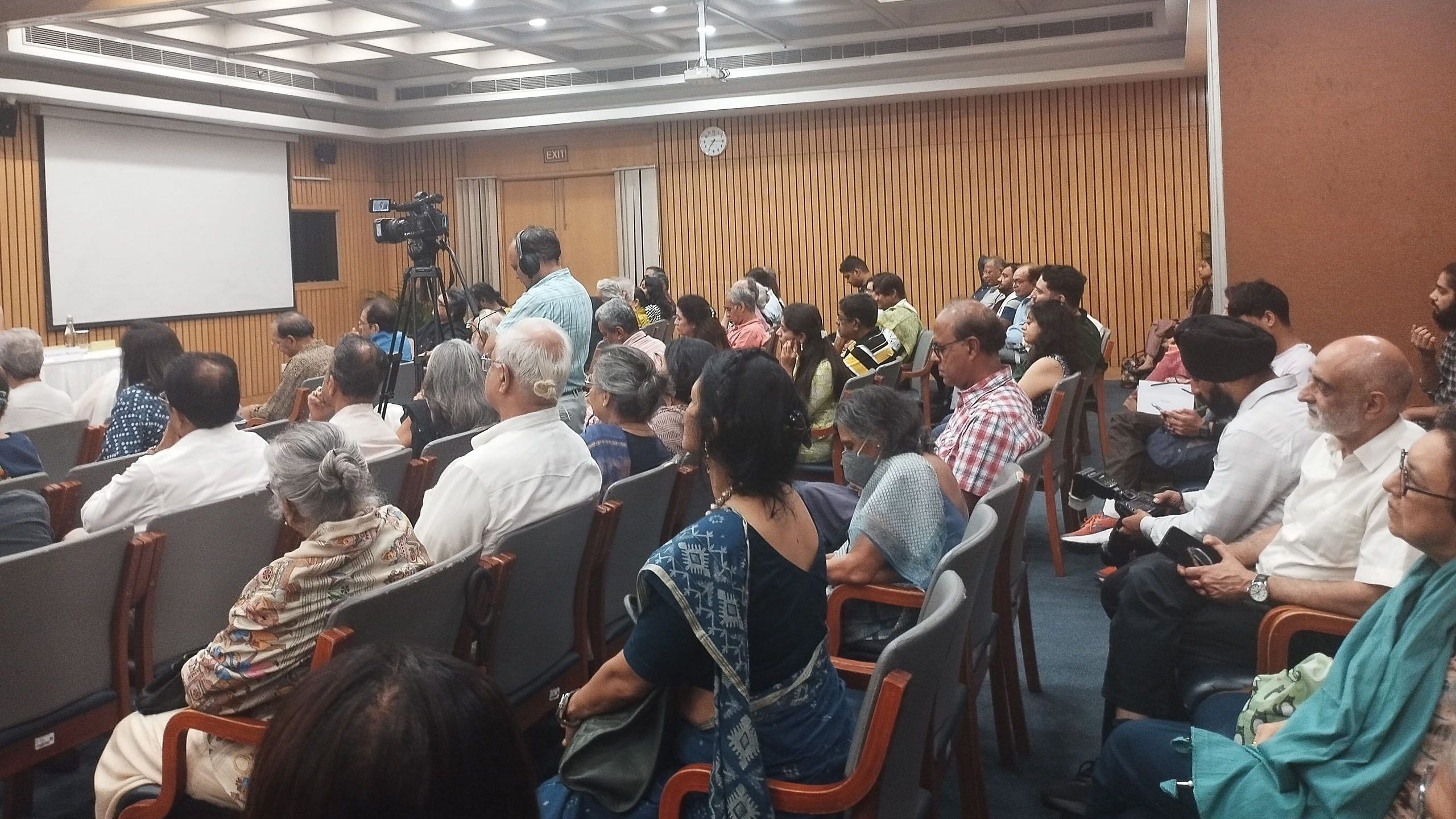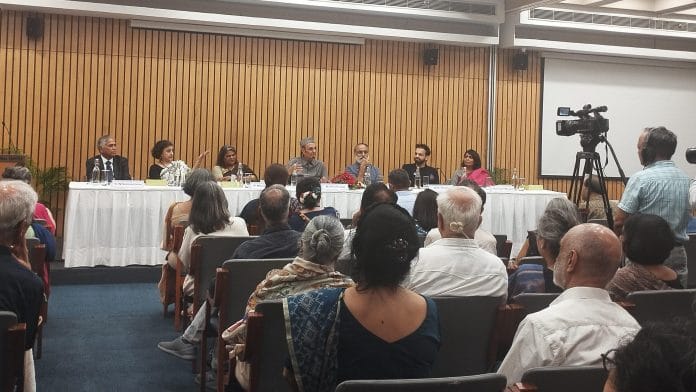New Delhi: A plate of food can be tasty, but it is also political, cultural, and gendered. It carries a region’s history, and the promise of a nation’s prosperity. From instant noodles to sambar—a discussion at Delhi’s India International Centre looked at food through the prism of history, culture, business—and caste.
“We are consuming the industry,” declared award-winning choreographer Navtej Singh Johar, one of the panellists at the release of IIC’s quarterly issue, ‘Food Cultures of India’. The statement caused the audience to crack up, but the ripples of laughter in the packed hall quickly subsided as Johar explained how the food industry was dictating our plate and palate.
“The food industries are trying to grab two things—food and land. And these are the only things I have to protect,” he said. As a result, the ties of tradition to food are being eroded.
The panel discussion swiftly transitioned between topics—all centred around the multifaceted role of food beyond mere nutrition. It touched upon food’s transformative impact on the socio-cultural landscape, its evolution with migration, the biases and prejudices it encounters, and relevant food policies. In essence, the conversation mirrored the themes of the IIC Quarterly, which features 22 essays on these subjects.

The many identities of food
When Bengali families prepare macher matha (fish head), the fishtail is kept aside for women. That’s because the head is more challenging to eat, said R Mahalakshmi, a professor at the Centre for Historical Studies, Jawaharlal Nehru University. This practice illustrates gender roles in food consumption.
According to Mahalakshmi, culinary practices create strong boundaries between ‘us’ and ‘them’, symbolising social hierarchies and power dynamics. Cooking and eating foster social cohesion through acts of belonging and solidarity. In India, while diverse culinary traditions exist, dominant discourses shape our civic and gustatory perceptions.
Mahalakshmi noted that historical and sociological studies have expanded our understanding beyond regional diversity to explore food-related identities shaped by class, caste, religion, and gender.
Even the terms used for food reflect locality and social position. She cited examples such as ‘Aharam’ in Tamil and ‘Bhojanam’ in Telugu, each indicating one’s social status and location.
Mahalakshmi also found the migration of people and food fascinating, noting it leads to new and innovative dishes.
“Because of migration, innovation comes in when we look at food; we invent a lot of things. You add a new ingredient and your new dish is made,” she said.
Elaborating, Mahalakshmi gave the example of sambar. While many consider it a traditional South Indian dish, it was actually invented in the royal kitchen of Shahaji I, son of Ekoji, who established Maratha rule in Thanjavur in 1676.
She also shared how the humble potato, now central to Indian cuisine, is not native to India.
“It was introduced by the Portuguese in western India. [Later], the British encouraged its cultivation in West Bengal,” she said.
But Johar has a different perspective on food. For him, food is inherently political. He argued that those who manipulate food can be easily exposed.
“Food is political, so I have a responsibility to engage with everything related to food politically,” Johar asserted.
Also read: ‘Leave Rogan Josh alone’— Why Kashmiris & Palestinians are protective of their recipes
Food and health
The conversation swiftly moved from industry, politics, and packaged foods to the role of public policy in nutrition.
Moderator Dr Karan Singh, former governor of Jammu and Kashmir, called for a ban on white bread and white rice, highlighting their adverse health effects. He pointed out that white bread and white rice lack the nutritive value found in brown rice and whole grain bread.
“By the time it becomes white, it has thrown away all the nutrition. This obsession with white rice and bread is absurd. It should be banned,” Singh asserted.
He highlighted the troubling reality that millions of children go to bed hungry every night, questioning how this could be acceptable in a supposedly great nation. Singh emphasised the importance of providing nutritious mid-day meals in schools, citing Tamil Nadu’s initiative of offering breakfast to primary school children as part of their mid-day meal programme.
“Equitable distribution of food is significant. There are a lot of malnourished children, yet we are exporting food. Unless every child gets food, we can’t call ourselves a great nation,” he added.
(Edited by Aamaan Alam Khan)







Puran poli , holige in Kannada Modak were all introduced to peshwas by their ministers who were from Karnataka. Manollasa written by kannada king of chalukya dynasty in the 12th century has mentions of lifestyle of kannada people and the cuisine. Even malla kambh and kabbadi are mentioned in the book. Do some basic research before you utter crap from such podiums
The author is quoted as an internet myth without doing any research. Sambar is not present in Maratha cuisine. The closest dish to sambar is called amti. Sambar is mentioned in Tamil literature long before the Marathas came to Thanjavur. There is no logical way a dish, if invented in Thanjavur, would spread only to South Indian states and not to any North Indian states or even be present in Maratha culture. Vinha d’alhos is a Portuguese dish that evolved into vindaloo, which is present only in Goan cuisine. We can see the relation in naming and preparation. Sambar has no such relation with amti. Congee/kanji is another dish that is similar across Kerala, Tamil Nadu, China, Korea, and Japan. Every region has some variation, but all countries refer to it as congee/kanji only. Sambar has no such connection with the Marathas.
Not a very useful for now. Dont make a fool by silly tweets or information. Try to research what our politicians and governments are doing great or not great and find solutions for it by providing valuable news.
Aarae O samba …It basically originated in the south in the marata kingdom of thanjavur in tamilnadu which is now staple of tamilnadu kerala & karnataka , like how Pappu is from Andra now there can be a debate whether it’s from Telengana or AP , People try making it in the north too……
You headline is very misleading. Even the body text says Sambhar was invented in Thanjavur. Last I heard, Tanjavur is in South India. Then how come your headline says Sambhar did not originate in South India? It appears the headline editor is not aware of history of South India especially of Maratha rule in Tamil Nadu.
No one calls food as ‘Aharam’ in Tamil. We call it ‘Saappaadu’ or ‘Soru’. Not the thoughts of some privileged 3% can be compared to be the thought of whole of Tamil Society.
Then how only south Indians mastered in cooking Sambar? Why you want where it was first cooked enjoy the taste and leave for your work.
Stop this nonsense about where sambar came from
It was the the south indian who found most of the dishes and language. North Indians were just show. My 2 cents worth to a writer who writes for money
Definitely originated in Thanjavur, by the then ruler, Sambhaji Bhosale.
As far one knows, Thanjavur is in South India.
Please do not give such erroneous statements for effect.